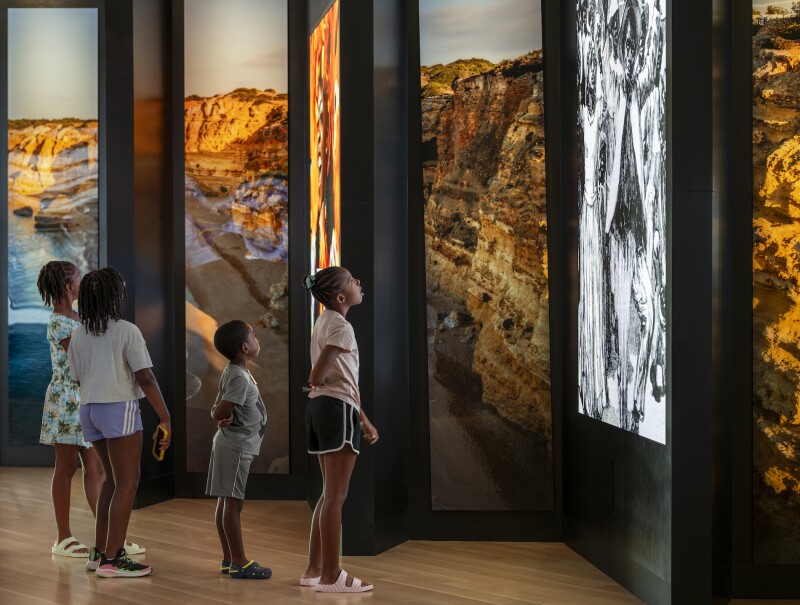Black history and Charleston are synonymous, from the Gullah-Geechee foodway traditions of okra soup and red rice to the very foundation of the city’s infrastructure, which was built almost entirely by enslaved people. In fact, it’s estimated that some 90 percent of Black Americans can trace at least one ancestor who arrived in Charleston’s ports.
“As a museum that focuses specifically on the African American experience, we have the flexibility and the responsibility to share history and culture that offers fresh perspective and breathes new life into a story that is often presented as a monolith,” says Malika N. Pryor, the museum’s chief learning and engagement officer.
Nearly 20 years in the making, the $100 million, 40,000-square-foot facility features nine distinct galleries that tell the story of how enslaved and free Africans shaped American history, in a setting just steps away from Gadsden’s Wharf, where nearly half of enslaved Africans were brought under horrific conditions almost 250 years ago. Today, the International African American Museum tells a remarkable story of tragedy turned to triumph. Conceived by the late architect Henry N. Cobb of Pei Cobb Freed & Partners (who also designed Boston’s John Hancock Tower), the museum’s architecture intentionally frames the ocean as a focal point, standing 13 feet above ground on pillars to serve as a floating memorial.
One of the museum’s gallery names is the Transatlantic Experience, which serves as the entryway to the museum and displays a video journey of diasporic history and cultural traditions spanning over 100 years, from the Middle Passage to great American migrations.
“Regardless of what’s happening in the larger world, providing that kind of insight into American and world histories matters. The fact that we can share with nuance, sensitivity, and honesty at a time when many would prefer that we do not engage the subject at all is an incredible gift and opportunity—even if it comes with its challenges,” says Pryor.
Other gallery rooms include the Atlantic Worlds Gallery, the South Carolina Connections Gallery, the American Journeys Gallery, the Carolina Gold Gallery, the African Roots Gallery, the Theater, the Special Exhibitions Gallery, and the Gullah Geechee Gallery–which features a multimedia, chapel-sized “praise house” showcasing the sounds of gospel music.
Currently on display through December 3 is artist Fletcher Williams III’s When It Rains It Shines exhibit, an immersive installation that invites viewers to understand what it means to exist in the South through a collection of personal memories and rituals. The museum’s first traveling exhibition, Follow the North Star, opens next spring and will explore the literal and metaphoric ways that African Americans have transcended their conditions to create new lives for themselves and future generations.
Also notable, IAAM contains the Center for Family History, a world-class genealogy and ancestry resource hub that allows visitors to research their family history through a collection of historical documents, digital archives, photos, and even one-on-one virtual sessions. The museum also features the African Ancestors Memorial Garden, which notes the historic significance of Gadsden’s Wharf via artistic installation and site objects that are free and open to the public. These include a large water feature that ebbs and flows with dancing silhouettes, paying tribute to the Atlantic Passage.
“We often describe the African American story, not so unlike many human stories, as one that lives at the intersection of trauma and triumph, unimaginable loss and indescribable joy,” Pryor says. “Framed at any given point, by local, national, and international references and topics, our guests are introduced to the African American journey in a way they may never have been before. The subjects can be heavy, the themes difficult, and yet the space is also bright and hopeful. The energy and design of the museum is meant to carry you through the entire story—lifting the visitor through the difficulty and reveling with you in the joy of tremendous accomplishments.”

The museum highly recommends buying tickets online.
Photo by Sahar Coston-Hardy/Esto
Plan a visit to the IAAM
- Purchase tickets: iaamuseum.org; ticket purchases can be made by phone at 843-872-5352.
IAAM is open daily Tuesday through Sunday from 10 a.m. to 5 p.m., and a timed-entry ticket is required, with the last reservation time at 4 p.m. The museum is closed on Mondays, as well as Thanksgiving Day and Christmas Day. General admission is $20, and youth (age 6–16), senior (62+), and military tickets are available at $10. For more information on planning a visit, purchasing tickets, or becoming a member of the museum, visit IAAM’s website.
For accommodations, the 155-room Dewberry Charleston offers a prime city center location, deep soaking tubs and canopy beds, and the James Beard–nominated Citrus Club bar on the ground floor. When hunger strikes, head to the barbecue staple Rodney Scott’s or, for fine dining that celebrates the region’s Lowcountry cuisine, Fig.











